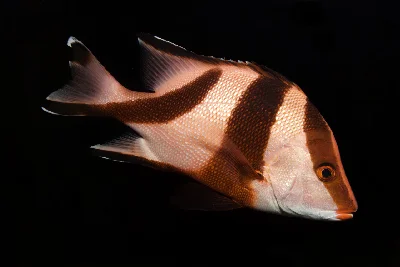Emperor Snapper
Lutjanus sebae
Lutjanus sebae, commonly referred to as the red emperor, emperor red snapper, or government bream, is a marine ray-finned fish belonging to the family Lutjanidae. This species is indigenous to the 🌊 Indian Ocean and the western 🌊 Pacific Ocean.
Originally described in 1816 by the eminent French zoologist Georges Cuvier as Diacope sebae, the type locality was not specified but is likely located along the Corundefineddel Coast of 🇮🇳 India or within 🇮🇩 Indonesia. The specific nomenclature honors Albertus Seba, a renowned Dutch pharmacist, zoologist, and natural history collector, famous for his Thesaurus of animal specimens published in 1734, featuring splendid illustrations of Indo-Pacific marine life, including Lutjanus sebae.
This species is characterized by a notably deep body, with a standard length exceeding twice its depth. Distinctive features include a steep forehead slope, a snout with either a straight or convex upper profile, and moderately developed preopercular knobs and incisions. The vomerine teeth are organized in a crescent or triangular configuration without posterior extension, and the tongue remains smooth and toothless. The dorsal fin comprises 11 spines and 15 to 16 soft rays, while the anal fin includes 3 spines and 10 soft rays, with both fins exhibiting sharply pointed rears. The pectoral fins possess 17 rays, and the caudal fin is weakly forked. Lutjanus sebae has a maximum recorded total length of 116 cm, though a length of 60 cm is more typical, and it can weigh up to 32.7 kg. The specimen displays a reddish to pink hue with similarly colored fins, and juveniles display distinct red bands running from the snout through various sections of the dorsal and pelvic fins.
Geographically, Lutjanus sebae enjoys a vast Indo-Pacific distribution spanning from Eastern Africa, through the southern 🌊 Red Sea, to 🇿🇦 South Africa, extending eastward into the 🌊 Pacific Ocean as far as 🇳🇨 New Caledonia (🇫🇷 Overseas France), further reaching 🇦🇺 Australia and southern 🇯🇵 Japan. In 🇦🇺 Australian territory, it is prevalent from Bunbury, Western Australia, encircling the coast to Sydney. There have also been recent Mediterranean Sea sightings near Athens, Greece, and Palermo, Sicily. The species thrives in both rocky and coral reef ecosystems, favoring flat areas with sandy or gravel substrates across a depth range of 5 - 180 meters, and it can live for up to 40 years.
As a predatory fish, Lutjanus sebae feeds on various smaller fish, benthic crustaceans, and cephalopods. It may form schools of similar-sized individuals or exist solitarily. The species mature slowly, with the average age of sexual maturity off the coast of the 🇸🇨 Seychelles being around nine years for both genders, and sexual maturity coinciding with fork lengths between 61 and 63 cm. Post-maturation, females experience a reduced growth rate compared to males, resulting in larger adult males. Spawning aggregations occur from October to April, marked by broadcast spawning of eggs and milt. Juveniles are known to shelter among sea urchin spines, while mature adults often migrate to deeper waters, returning to shallower areas during winter.
Lutjanus sebae is significant both commercially and as a game fish, and it is cultivated for the aquarium trade. In Australasia, it is colloquially known as the government bream due to the juvenile form's red bars, humorously likened to red tape.
Comments
Please, sign in to leave comment
No Comments yet
Last Update: May 28, 2025

